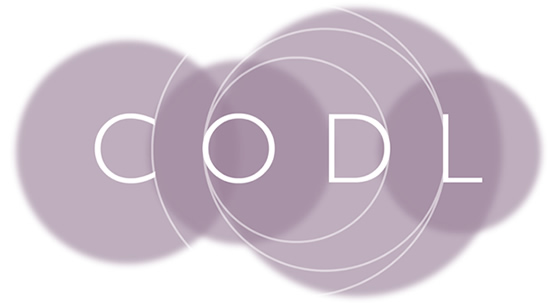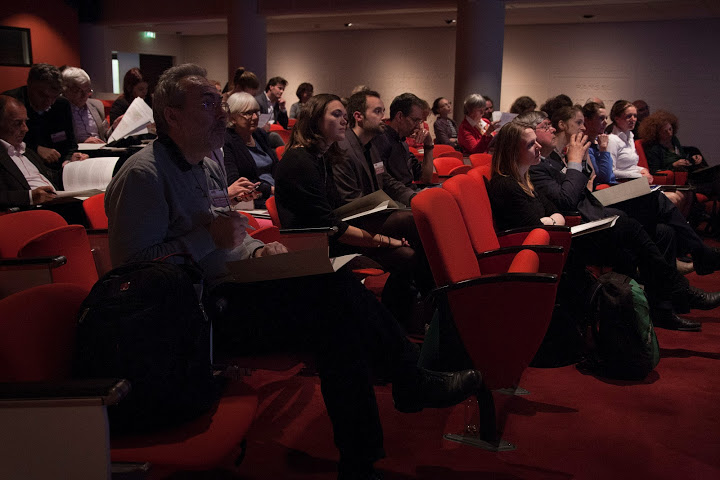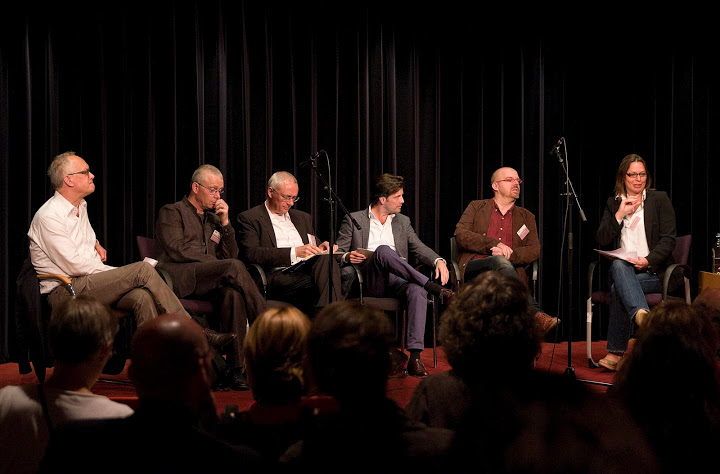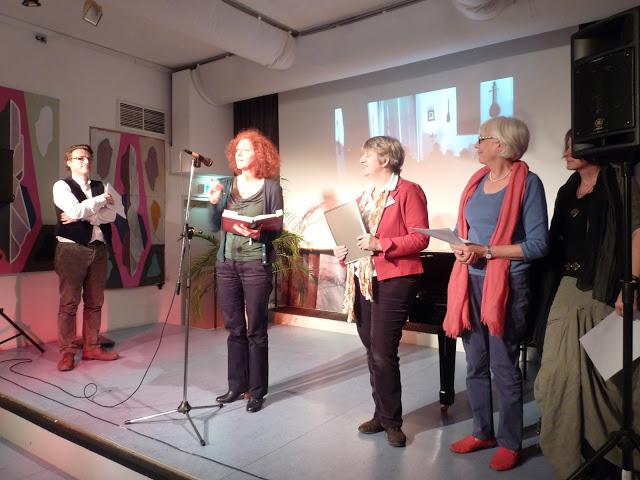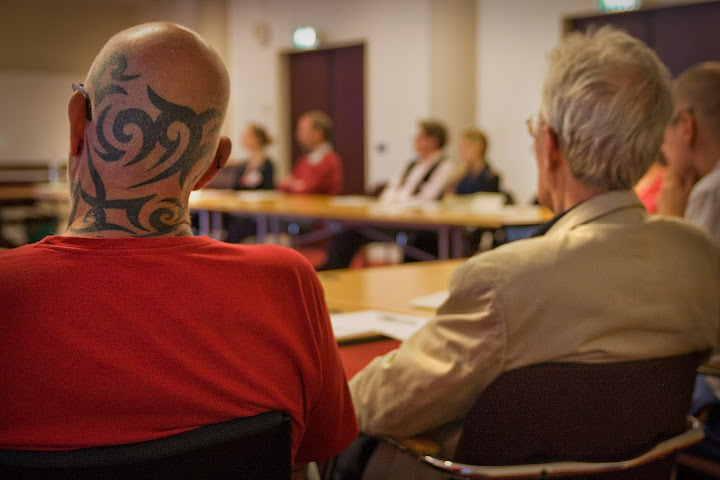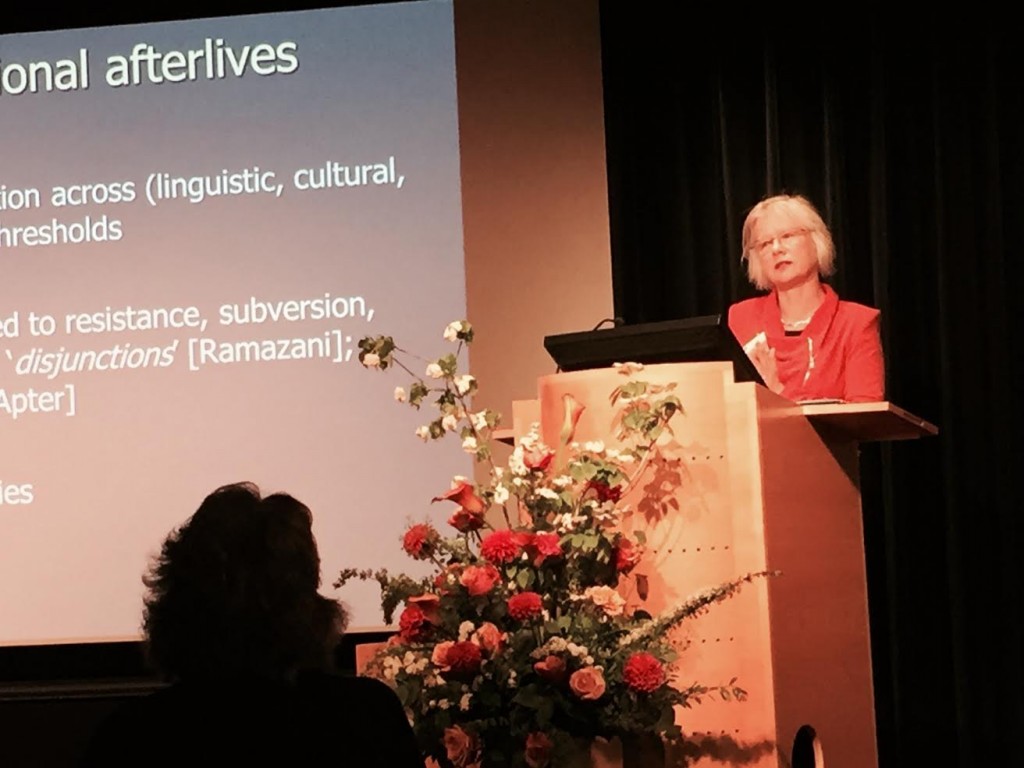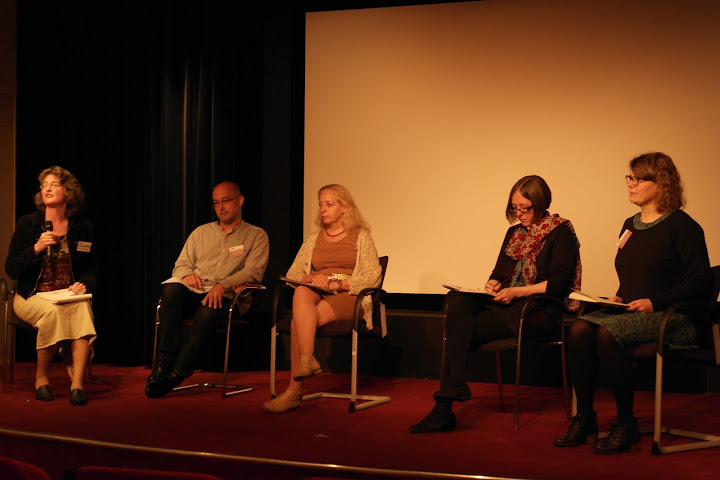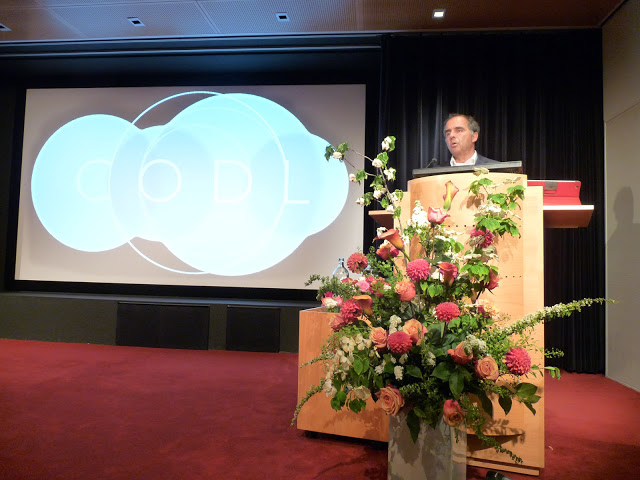CODL conference The Hague 28-30 May 2015
‘Het is niet onopgemerkt gebleven.’ CODL’s official baseline – borrowed from the penultimate sentence of Gerard Reve’s acclaimed debut novel De avonden (an English translation of which will be published by Pushkin Press later this year, nota bene) – could just as well describe the many perspectives and discoveries shared over the course of our third ‘Circulation of Dutch Literature’ international conference, held on May 28-30 at the National Library of the Netherlands in The Hague.
70 participants from 12 countries heard new research on the reception and circulation of Dutch literature covering a range of (inter)national and contexts and periods, all loosely organised around CODL’s 13 focus texts. The programme included six keynote lectures, 50 paper presentations, and two round-table discussions. (More on all this below)
Between sessions, participants were treated to a special exhibition compiled especially for CODL by National Library curator Ad Leerintveld. The permanent collection was also open throughout the conference for participants to browse. An evening programme at the Haagse Kunstkring on Thursday, featuring CODL focus texts performed by conference goers, and a conference dinner on Friday rounded out the schedule.
With an eye to disseminating the excellent work presented by researchers in the CODL network (cue that baseline again), CODL organisers will begin compiling a book of selected contributions from conference participants. A call for papers will be issued in the coming weeks, so stay tuned.
But before we set our sights on the future, let us look back on a successful conference with the help of some of its more memorable quotes:
‘No one can change a man like Shirley Temple’
Deborah Cartmell
After warm words of welcome from the National Library’s acting director Lily Knibbler and CODL co-leader Ton van Kalmthout (Huygens ING), adaptation studies scholar and Hollywood buff Deborah Cartmell (De Montfort University, UK) took to the podium to deliver the first keynote, ‘Adaptations for Children – Pre- and post-code Hollywood’. (‘Code’ refers to Motion Picture Production Code, an industry-imposed set of moral guidelines in effect from 1930 to 1968 that spelled out what was and wasn’t acceptable content in Hollywood-produced motion pictures.)
Cartmell presented a penetrating analysis of gender representations in pre- and post-code Hollywood, zooming in on the figure of Shirley Temple and her overlapping status as wholesome morality figure and sex symbol, particularly to older men. Cartmell went on to relate this to female characters in Disney animated films (enter Snow White, whose charms could redden the cheeks of even the most crotchety of old men, Grumpy). Disney’s figuring of animated characters (Snow White) after real-life stars (Shirley Temple), Cartmell emphasised, can be seen as a deliberate strategy to exploit the duplicitous code-era visual politics of morality and male desire and, in so doing, beat Hollywood at its own game – and this in lieu of pursuing other, more modern, code-breaking avenues.
‘All but one of the authors being discussed at this conference are dead’
After parallel-running panels on youth adaptations of Conscience’s De leeuw van Vlaanderen and the reception history of Hermans’ De donkere kamer van Damocles, the full conference reconvened for a presentation by Arno Kuipers of the National Library and Marlies Hoff of the Dutch Foundation for Literature on digital databases of translated Dutch literature.
This was followed by a round-table discussion on the role of mediators in the worldwide circulation of Dutch-language literature. At the table were Koen Van Bockstal of the Flemish Literature Fund, Geert Joris of the Dutch Language Union, independent literary agent Tino Köhler, Ton Naaijkens of the Centre of Expertise for Literary Translation at the University of Utrecht, and Tiziano Perez of the Dutch Foundation for Literature. The discussion was moderated by Sigrid Bousset.
FLTR: Ton Naaijkens, Koen Van Bockstal, Geert Joris, Tiziano Perez, Tino Köhler and Sigrid Bousset
The back-and-forth gave way to a (periodically heated) dialogue with academics in the audience. How to promote Dutch and Flemish authors abroad and train competent literary translators at home in the face of dwindling public funding and the sometimes conflicting prerogatives of commercial viability and literary-historical relevance? What are the consequences of promoting and translating contemporary, living writers over the important (but often dead) Dutch-language writers of the past?
Conference goers perform during the evening programme at the Haagse Kunstkring
Rounding off Day 1 was an evening programme at the Haagse Kunstkring. Highlights: readings from Hadewijch and Minoes (performed in five languages!) by CODL conference goers.
‘Dutch literature is breaching the dikes’
Day 2 opened with a keynote lecture by Nico Wilterdink (University of Amsterdam) titled ‘Breaching the dikes: the international reception of contemporary Dutch translated literature (1980-2012)’. Wilterdink probed book reviews published about Dutch literature in German, French, British and American newspapers to gauge the reception of Dutch literature abroad.
His results show steadily increasing press coverage across the board, fueled by a growing number of translated titles. Germany stands out as the only national press with both a developed conception of and taste for Dutch literature, even occasionally holding Dutch writers up as examples to be followed by its own national writers. Alternatively, in French, British and American newspapers, a coherent image of Dutch literature in se has thus far failed to materialise – the French are well-meaning but superficial, the British preoccupied with their own writers, the Americans ignorant. When Dutch writers did make the papers, emphasis tended to be placed on their individual merits, removed from any connection to a Dutch literary tradition.
Nico Wilterdink
Wilterdink went on to describe changes in the literary and cultural world system resulting from the rise of English as the unrivalled world language after World War II, which shifted the centre of power in the global literary field away from Paris and toward the United States. This shift, in turn, gave credence to the United States’ centrist and universalist tendencies and tastes (if an international author is worth reading, his work will de facto find its way to the United States), which continues to have important consequences for the reception of Dutch literature today. One such consequence: many Dutch writers are stigmatised from the get-go due to their ‘funny’ names. For more on all this, see Wilterdink’s new book.
‘It doesn’t get much funnier than Joke‘
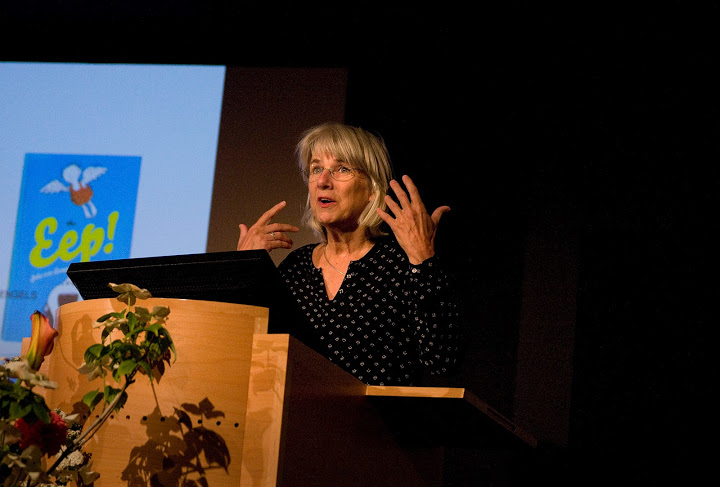
Joke van Leeuwen
Openly defying the Funny Name Rule, internationally-acclaimed Dutch-Flemish author Joke van Leeuwen took to the stage to present her keynote, ‘Why I cause my translators headaches’. With varying measures of pleasure and lament, she recounted a number of headache-inducing idiosyncrasies (iep!), including a tendency to pepper her children’s books with playful language, onomatopoeias and literal illustrations.
The conference then broke out for a second round of parallel-running panels: one featuring papers on the profiles, motives and strategies of Hadewijch mediators, another with papers on Haasse’s Oeroeg, Conscience’s De leeuw van Vlaanderen and Heijermans’ Op hoop van zegen.
‘We need to zoom back in on mediators’
Reine Meylaerts
After lunch, the conference reconvened for Reine Meylaerts’ (KU Leuven) keynote ‘Studying Cultural Mediators in Small Literatures: How and Why?’. Arguing for a change of focus away from collective schemes and structures (cf. Toury’s model for Descriptive Translation Studies), Meylaerts emphasised the importance of studying cultural transfer at the level of the individual mediator. She unpacked the idea of the (inter)cultural mediator, who is part author (often writing in multiple languages), (self-)translator, publicist, artistic/institutional mediator, collaborator and even plagiarist, all at the same time (e.g. Georges Eekhoud, Stijn Streuvels, Gaston Pulings). An actor- and process-oriented perspective, urged Meylaerts, is uniquely equipped to tease out these complex forms of transfer, which are especially active in small, linguistically fluid literatures.
Friday afternoon continued with two more rounds of parallel-running panels, including papers presented on Elsschot’s Kaas, Elckerlijc, Verhulst’s De helaasheid der dingen, Haasse’s Oeroeg, Couperus’ De stille kracht and a paper on the role of the literary translators as mediators. The day concluded with a conference dinner.
‘This is the resistant recycling of Walter Scott’
Ann Rigney
Ann Rigney (University of Utrecht) opened the third and final day of the conference with a morning keynote titled ‘Transnational Reception as Writing Back: Walter Scott in India’. She examined the profiles of two Walter Scott-inspired writers working in British-controlled India, Bankim Chandra Chatterjee and Abdul Halim Sharar, showing how Scott’s work was translated, adapted, and appropriated as an imaginative resource in formulating an anti-colonial counter-memory that Scott himself could not have anticipated – but might perhaps have welcomed.
Rigney’s lecture was followed by the conference’s second round-table discussion, this time addressing the topic of large-scale research projects focused on the circulation of literature. At the table were Cecilia Alvstad (University of Oslo), Petra Broomans (University of Groningen), Rajendra Chitnis (University of Bristol), Henriette Partzsch (University of Glasgow) and CODL’s own Orsolya Réthelyi (EötvösLorándUniversity), five researchers at the helm of ongoing or recently concluded projects.
FLTR: Orsolya Réthelyi, Rajendra Chitnis, Petra Broomans, Henriette Partzsch and Cecilia Alvstad
The panelists sketched their respective research projects and shared best practices: tailor your proposal to the call; frame cultural transfer and transmission in a compelling way (e.g. as a ‘survival strategy’ for small literatures); use the word ‘advocate’ as a synonym for ‘mediator’; create your own nonlinear pathways and approaches to literary culture; frame ‘small literatures’ in relative terms; define translation broadly to include adaptation (e.g. use ‘travelling texts’ as a synonym for translation); be transparent and clear about your methodological choices…
Participants then made their way to the two final, parallel-running panel sessions, with papers treating, inter alia, the emerging role of online book reviewers in the transmission of Dutch literature to the English-speaking world and the international reception of Annie M.G. Schmidt’s Minoes, Vondel’s Lucifer, and Heijermans’ Op hoop van zegen.
‘The international study of Dutch literature is thriving’
Frits van Oostrom
International. The word resonated throughout the sixth and final keynote by Frits van Oostrom (University of Utrecht), which doubled as a reflective stocktaking of the three-day conference. Looking to the future, van Oostrom called out three promising trends: the success of Dutch Studies programmes at universities abroad (astonishingly, van Oostrom pointed out, there are more first-year students of Dutch at Poland’s University of Wrocław then there are at the University of Utrecht); increasing internationalisation among scholars working in Dutch literature (hat tip CODL), and advances in digital humanities. Van Oostrom targeted technology as a crucial tool that must be leveraged if scholars in the humanities are to successfully counter the image that “we are all just ruminating old stuff”. He urged the audience to “create digital campfires” and embrace open access when disseminating research results. “Internationalisation has opened exciting new avenues of investigation and creativity,” concluded van Oostrom. “The international study of Dutch literature is thriving.”
And with that, all that remained was the formal closing of the conference. That task went to CODL co-leader Elke Brems (KU Leuven). “In the four years of CODL’s existence, we have formed and consolidated a collaborative network of researchers where there was none before,” she said. “Even as the project in its current form is coming to a close, I am confident that the network we built together will continue to bear fruits long into the future.”
